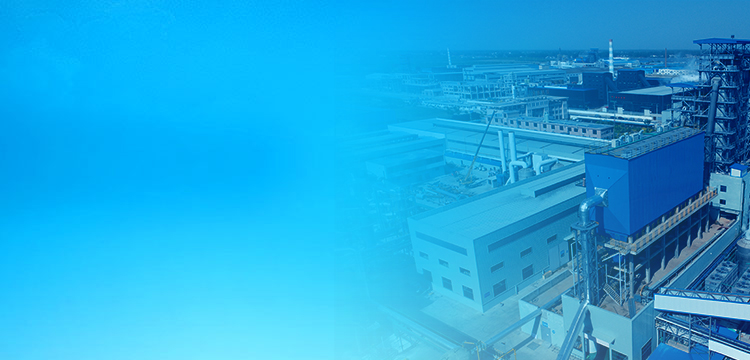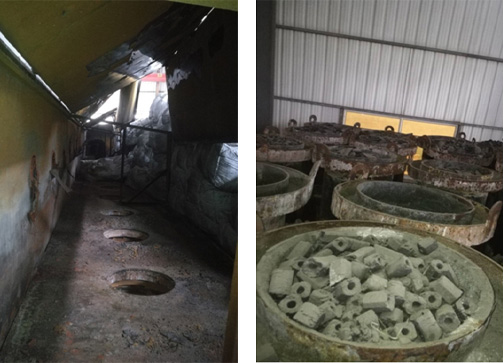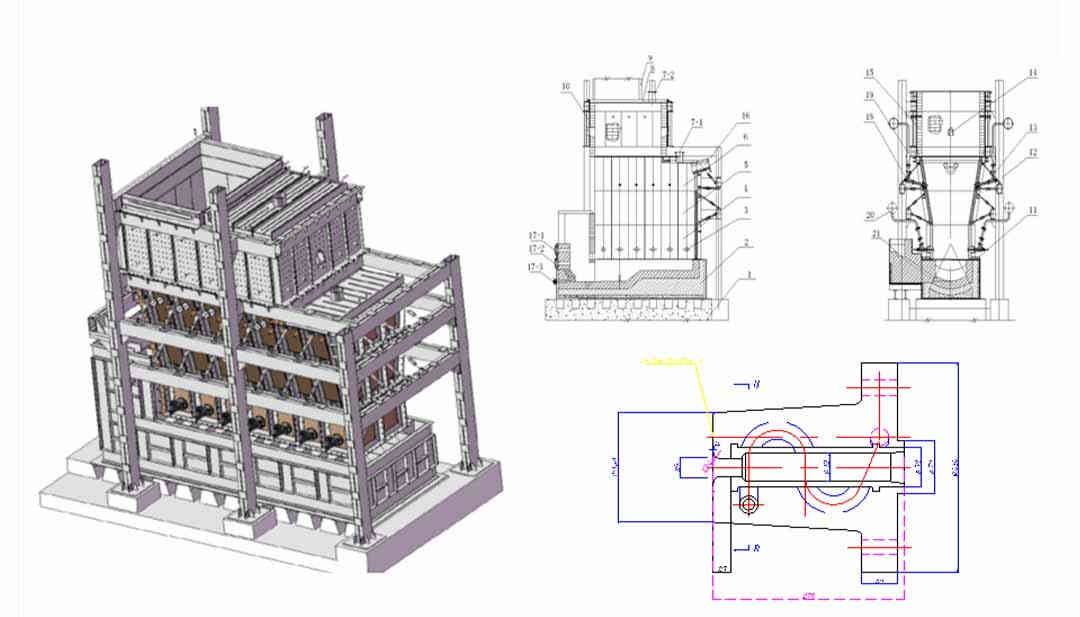
 CN
CN

 CN
CN

Solid/hazardous waste treatment solution provider
Resource recycling system equipment integrator
Low temperature pyrolysis technology of waste circuit board
Process principle——
Waste printed circuit boards are mainly composed of metal components (copper, iron, aluminum, tin, gold, silver, etc.), organic components (brominated epoxy resin, etc.) and glass fibers, in which the organic components are degraded by pyrolysis process. Pyrolysis process is the process of thermal decomposition of substances, and organic substances will undergo decomposition reaction in the process of heating. The pyrolysis reaction of brominated epoxy resin, the binder in waste circuit board, in oxygen free environment is as follows:

The pyrolysis process of waste circuit board is carried out at a temperature lower than 700 ℃. The pyrolysis oil is discharged from the pyrolysis furnace in the form of gas and pyrolysis gas in the form of mixture. Part of the pyrolysis oil is recovered through the air condenser (200 ℃ - 250 ℃), and the pyrolysis oil directly enters the pyrolysis oil storage tank; The pyrolysis oil and gas mixture continues to further separate the pyrolysis oil through electric oil capture and gravity oil capture. The complete separation of pyrolysis oil can be realized through the electric oil capture and gravity oil capture processes. The separated pyrolysis oil directly enters the pyrolysis oil storage tank, which can be used as fuel for combustion in other furnaces or as raw material for extracting chemicals; After the purified pyrolysis gas is washed with Na2CO3 solution, all HBr gas in the pyrolysis gas will be absorbed to form NaBr solution. After crystallization treatment, NaBr can be obtained as product takeout. The condensate produced in the crystallization process will be returned to the washing gas for Na2CO3 solution; After gas washing, electric dust collection and pressurization, the pyrolysis gas is used as fuel gas to heat the combustion of the pyrolysis system, and the surplus fuel gas is used for heating other processes of the owner.
Process principle——
The process is simple and reliable without manual disassembly, which reduces the difficulty of subsequent crushing and sorting; The concentration of dioxin in the waste gas in the treatment process is far lower than the standard limit, which has significant environmental protection advantages; The treatment scale is large, the cost is low and the process stability is good.
High value comprehensive recycling technology of waste magnesium chromium refractories
Technical introduction——
Magnesia chrome refractory is an important part of furnace lining and plays an irreplaceable role in non-ferrous metallurgy industry. However, the treatment of waste magnesia chrome refractory has become a difficult problem for large and small enterprises in recent years. The traditional treatment methods can not effectively recover fine valuable metals, the erosion mechanism is not clear, and the performance index of recycled refractory bricks is poor, resulting in the low comprehensive utilization rate of this kind of refractory bricks.Based on the research of "erosion mechanism and microstructure analysis of magnesia chrome refractory brick - Interface Chemistry for efficient recovery of fine metal elements - regeneration, preparation and performance regulation of magnesia chrome refractory brick", the company has independently developed key technologies such as gravity flotation process, selective recovery of valuable metals such as gold, silver, lead, bismuth and copper, reduction chlorination and volatilization process, impurity removal, press molding high temperature calcination process and regeneration, Realize the dual purpose of valuable metal recovery and refractory brick regeneration.
Scope of application——
The waste magnesium chromium refractories used in nonferrous smelting furnaces mainly include lead, silver, copper, antimony, bismuth and other waste magnesium chromium refractories used in smelting furnaces.
Technical advantages——
——Heavy flotation concentrate has high metal grade
After separation, the grade of silver in the concentrate can reach more than 10%, and the grade of other valuable metals (Cu, Pb, Bi, Sb, etc.) can reach more than 35%;
——High comprehensive recovery rate of valuable metals
The recoveries of silver, lead, bismuth and other valuable metals can reach more than 95%;
——Environmental protection, zero pollution and no waste of resources
The wastewater in the re flotation process can be recycled, which can not only save the water cost, but also have no impact on the environment;
The waste gas produced by reduction chlorination volatilization process can be used as smelting raw materials through precipitation collection. After treatment, the waste gas can meet the gas emission standard;
Concentrate can be used as smelting raw material to recover metal, and tailings can be used as raw material for recycled refractory materials, so as to realize high-value comprehensive utilization of refractory materials.
patent——
A method for treating flotation tailings of waste magnesium chromium refractories (CN 107573084 a)
A method for treating waste magnesium chromium refractory (CN 107716088 a)
A method for separating valuable metals from flotation tailings of waste magnesium chromium refractories (CN 107419102 a)
A method for recovering metallic copper from copper smelting waste refractory by flotation (CN 106179769 a)
A method for recovering valuable metals from waste refractory materials by gravity separation kerosene agglomeration flotation combined process (CN 106269170 a)
Clean treatment technology of arsenic containing flue gas
Technical introduction——
High arsenic content of raw materials is an important trend in the non-ferrous smelting industry. Arsenic containing materials will volatilize into the smelting flue gas during smelting and roasting, causing many disadvantages to the subsequent acid making, metal smelting and other processes. This technology adopts the flue gas arsenic collection process of "high temperature membrane filter + quench tower" to obtain high-grade arsenic trioxide (the purity can reach more than 99%), so as to realize the selective collection of arsenic and avoid producing a large amount of high arsenic soot. The arsenic trioxide obtained in the arsenic collection process can be prepared by vacuum reduction process to obtain metal arsenic.
Process description——
After cooling and cyclone pre dedusting of smelting arsenic containing flue gas, the flue gas enters the high-temperature membrane filter at the temperature of 360 ~ 400 ℃. The high-temperature membrane filter intercepts the dust in the gas, while As2O3 passes through the filter in a gas state to realize the separation of As2O3 and solid. The filtered gas is cooled rapidly, and As2O3 in the gas forms solid due to the decrease of temperature, Then the high-grade As2O3 is collected by the combination of quench tower and bag dust removal, and the gas after purification and arsenic removal enters the downstream process. High grade As2O3 products and charcoal are proportioned in a certain proportion and then enter the vacuum carbon reduction furnace. According to this, arsenic oxide volatilizes into gas in the preheating section through the preheating and reduction area. Under the traction of negative pressure, it scorches the charcoal at high temperature in the lower part of the reduction furnace, and reacts As2O3 with carbon at 700 ~ 800 ℃ to obtain metal arsenic.
Technical advantages——
——Arsenic resource utilization
The high temperature membrane filtration process can fully meet the requirements of dust recovery and arsenic trioxide purification in flue gas. The quench arsenic collection process can realize the efficient collection of arsenic trioxide and achieve the purpose of selective arsenic collection.
——Less discharge of three wastes
The treatment of such high arsenic flue gas by traditional dust collection process will get a large amount of high arsenic soot that is not easy to treat. At the same time, the arsenic collection rate is low, which will not only affect the subsequent acid making process, but also produce a large amount of arsenic containing waste acid, causing great pressure on water supply treatment.
——High product quality
The purity of arsenic trioxide collected by this technology can reach more than 99%.
Broaden the source of raw materials
In order to reduce the arsenic load of high arsenic smoke and dust and sewage treatment, the as content in the furnace is required to be ≤ 0.5%. The application of this technology can greatly improve the arsenic content in the raw material.
Comparison of preparation processes of metal arsenic

Traditional craft
Disadvantages:
The unorganized discharge of arsenic oxide in the production process is serious, and the operation safety is not guaranteed;
Insufficient reduction degree and low product yield;
The product quality is not guaranteed and the yield is low.
Vacuum reduction process
Direct extraction of cathode copper from lead matte
patent——
Technical advantages——
Oxygen enriched side blowing smelting technology of regenerated lead
Technical introduction——
Recycled lead oxygen enriched side blowing smelting technology is one of the core technologies of our company. This technology realizes one-step reduction of lead paste through oxygen enriched side blowing single furnace to obtain crude lead and lead containing & lt; 1.5% of the slag and purify and enrich sulfur dioxide through ionic liquid circulating absorption technology to meet the requirements of producing refined acid. This technology has the advantages of less investment, large treatment scale, low operation cost, simple operation, safety and reliability. It is an advanced domestic recycled lead smelting technology at present. The company has the design and R & D capability of a complete set of regenerated lead oxygen enriched side blowing and its supporting flue gas acid making technology and equipment, and can provide high-quality technical services.
Technical advantages——
Low energy consumption, no coke and recyclable waste heat;
The furnace type is closed and the unorganized discharge is small;
The flue gas can be used to make acid, there is no desulfurization tailings, and the desulfurization cost is low;
High automation level and low labor intensity.
Comparison of smelting furnace types of lead paste oxygen enriched side blowing furnace
